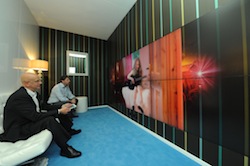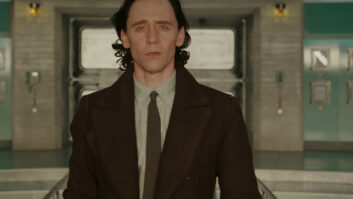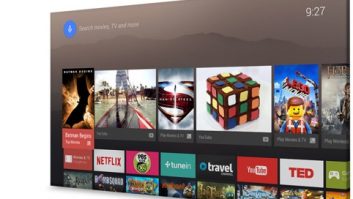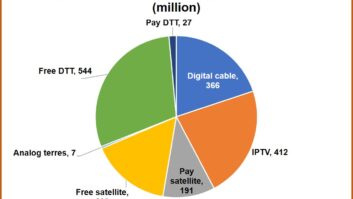
Simon Parnall, UK vice president of technology at NDS, is a man with a vision – and, refreshingly, his vision isn’t one where we can watch the same content on everything from the TV to a wristwatch, writes Ian McMurray. His vision sees the end of TV as we know it.
“No more black box sitting in the corner of the room,” he said. Instead, the compelling demonstration – hidden away on the company’s IBC stand – uses the wall as the screen. “Now,” he said, “consumers can watch content in the size and shape most appropriate to the content: a newsreader will occupy just a small viewing space, for example, while a football match or movie might occupy the entire wall.”
Parnall points out that, increasingly, screen real estate is a barrier: there just isn’t enough for all the opportunities to fill it – which often means that the main picture is annoyingly overlaid. The NDS demonstration shows how TV content can remain unspoiled – but with all the ancillary data and commercial activity in view, but not distractingly so. And, when no-one is watching TV – it no longer exists. The screen is now just a wall.
Parnall is the first to admit that the technology isn’t there yet. It will need new kinds of display – OLED, perhaps, rather than the multiple LCD panels being used for the demonstration. “We believe those new displays will be in place within five years – and so too will the silicon,” he notes. “But what we’re thinking about today is how we will use those displays and that silicon when they’re ready.”
“Everyone who’s seen this thinks we’re on the right track,” he smiled. It’s hard to disagree with them.
Stand:1.A71 Simon Parnall, UK vice president of technology at NDS, is a man with a vision – and, refreshingly, his vision isn’t one where we can watch the same content on everything from the TV to a wristwatch, writes Ian McMurray. His vision sees the end of TV as we know it.
“No more black box sitting in the corner of the room,” he said. Instead, the compelling demonstration – hidden away on the company’s IBC stand – uses the wall as the screen. “Now,” he said, “consumers can watch content in the size and shape most appropriate to the content: a newsreader will occupy just a small viewing space, for example, while a football match or movie might occupy the entire wall.”
Parnall points out that, increasingly, screen real estate is a barrier: there just isn’t enough for all the opportunities to fill it – which often means that the main picture is annoyingly overlaid. The NDS demonstration shows how TV content can remain unspoiled – but with all the ancillary data and commercial activity in view, but not distractingly so. And, when no-one is watching TV – it no longer exists. The screen is now just a wall.
Parnall is the first to admit that the technology isn’t there yet. It will need new kinds of display – OLED, perhaps, rather than the multiple LCD panels being used for the demonstration. “We believe those new displays will be in place within five years – and so too will the silicon,” he notes. “But what we’re thinking about today is how we will use those displays and that silicon when they’re ready.”
“Everyone who’s seen this thinks we’re on the right track,” he smiled. It’s hard to disagree with them.
Stand:1.A71







